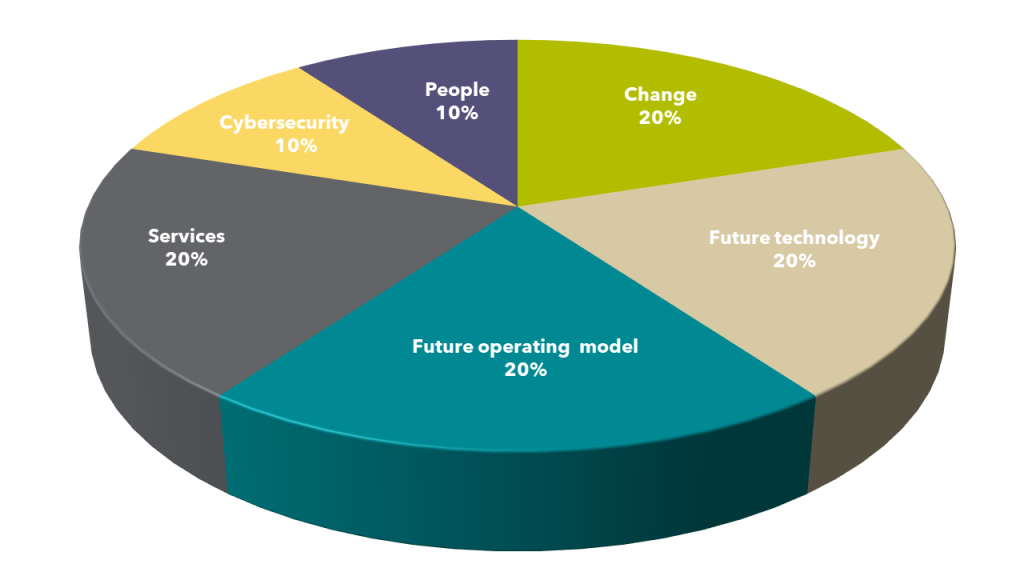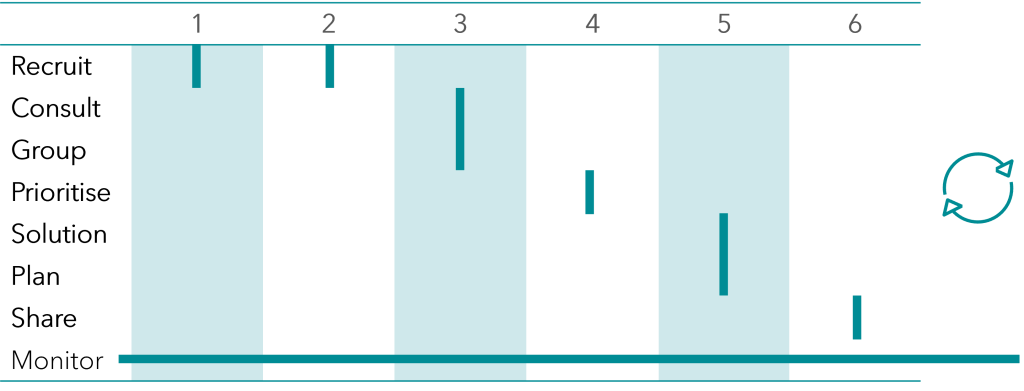Simple strategic effectiveness for CIOs & CDIOs

key fact
To make maximum impact, we suggest that CIOs & CDIOs spend up to 20% of their time iteratively improving ways of working
Time to think
For most CIOs and CDIOs delivery issues still dominate.
For years, leading analysts, advisors and practitioners have recommended increasing the proportion of time spent away from day-to-day services and projects, to make room for strategy and innovation—but of course this is easier said than done.
Our own suggestion is for IT leaders to spend:
- 20% of their time running services
- 20% delivering change
- 10% advancing cybersecurity, and
- 10% on their people.
This still leaves:
- 20% for future tech and architecture, and
- 20% for the future operating model.
Inevitably, much of our time in all 6 areas of focus will be spent in meetings. But it’s critical that not all your time is spent that way. Almost everyone also needs time to think independently, to do their best work.
These percentages are a good basis for managing your time, but you might need to tweak the split in your organisation. Whatever numbers you choose, it’s important to anchor to them, even if sometimes you need to flex away substantially. Your reputation as an agent of positive, lasting change will likely depend on it.
Unfashionable as it may seem at the top table, it can help to block diary time for thinking, planning, and learning (which will seldom seem like top priorities otherwise). Many people also find it helpful to keep a personal timesheet, to see how closely their actions match their intent, then they can purposefully rethink their time commitments in response to what they see.
Figure 1 – How could CIOs & CDIOs allocate their focus, time and energy
Future operating model
In this insight we’ll zoom-in on the future operating model work that we believe you should be driving in that last 20% of your time.
If you’re ever to meaningfully improve the way your team operates, then its central questions could scarcely be more important. They are:
I. “How will we work more effectively in future?” And:
II. “How will we change quickly and painlessly, to work that way?”
Sampling some frequent problems from our recent client work, it’s probable that you’re suffering from one or more of the following limitations:
- A poor understanding of (or poor control over) inbound demand for IT,
- Incompatibilities between digital & traditional delivery, complicating monitoring & governance,
- Difficulties recruiting and retaining to meet demand,
- Debate about the real value of the central IT portfolio, or
- Risk imbalance, either threatening instability or blocking innovation.
A CIO or CDIO committing 20% of time to limitations like these should be able to make some material progress quickly.
A simple approach
Whatever your starting point, it helps to have a methodical approach.
You’re likely to find that overcomplexity in your current operating model is a common theme, so let’s keep our method for tackling it as simple as possible. We’ve been successful using the following steps:
1. Recruit
Select a small set of people whose opinions you trust—but try to ensure diversity, so you don’t just reinforce your own views (beware the Johari window).
That diversity might be based on seniority, tenure, specialism or experience—ideally taking all of these into account. Sometimes it also helps to seek selected views from outside the organisation (e.g. from customers, suppliers, advisors or analysts).
2. Consult
Take time to interview those people, initially one-to-one, to gather a set of findings.
It’s fine to carry hypotheses into the meetings, but best not to let them dominate the discussion.
Reflect on what you learn, looking for patterns across the set of interviews, but also consider dialectics—taking time to make sense of diametrically opposed views.
3. Group
It’s helpful to see how the findings cluster into groups. If they’re mostly in one or two groups, it might make sense to dive deeper there before continuing, to understand interrelationships amongst the issues.
There’s an art to creating the most useful groupings, but if you’re stuck you could use a Capability Model (like ours) or create your own more minimal set. One option is to use a value chain like the one below, to arrive at groups like these:
- Input issues (funding, staffing, sourcing)
- Execution issues (methods, processes, tooling, roles, architecture)
- Control issues (governance, authority, monitoring, reporting)
- Output issues (implementation, benefits).
Figure 2 – Using simple categories for operating model improvements
4. Prioritise
To remain objective, decide ahead of time how you’ll prioritise the findings. Most likely you’ll use importance and urgency, but you might also take account of alignment to wider organisational goals.
With properly prioritised findings you can focus on the most important fixes, biting-off only as many as you can chew.
5. Solution
Get creative and devise a few competing ways to solve all but the simplest problems—seeking help from experts. Consider getting help here, bringing together experts and creative thinkers under firm facilitation.
For each solution option, capture what would change, how it would change, and who most needs to participate. Estimate and capture the likely cost, time taken, and risks along the way.
Score your options sensibly before selecting a favourite. A weighted decision matrix can help, but as CIO or CDIO you’re uniquely well-placed to make good judgements, so be sure to also sense-check what it tells you.
Quick wins are nothing to be ashamed of, but they shouldn’t be all that you care about. (Too much tactical focus is probably exactly how you arrived at today’s overcomplexity.)
6. Plan
Next, develop a roadmap you can act upon—ideally with people and budget you already hold. On a timeline, position your proposed solutions, examine any inter-dependencies, and consider who could lead each piece of work. It needn’t always be the most obvious person, and initiatives such as these can be excellent stretch activities for a high-potential early career colleagues or other active enthusiasts. Be sure to sit back and sense check your plan, end-to-end at this stage.
Finally,
7. Share
Everyone finds encouragement in a vision for improving ways of working, and most technologists like to see that there was an analytical approach behind it. Win mindshare and practical support at the same time, by presenting your plan to your team. Listen, and you’ll hear further feedback here, but as CIO or CDIO, it’s important not to feel compelled to accommodate everyone else’s views.
Sustained improvement
The simplicity of this approach should allow you to run through the 7 activities described above in as little as 6 weeks, even with just a 20% time commitment (figure 3).
So while you might choose to use this approach only periodically, it’s probably far better to iterate continuously, making it as much a part of your routine as the all-hands meeting—and avoiding the need to mobilise afresh each time.
It can help to think of your operating model as an evolving “Product”, with you as the “Product Owner” maintaining a backlog of candidate changes.
Figure 3 – A fast, iterating plan for effecting improvement
We’ve used this approach successfully before, so can help you get started quickly. And to industrialise, be sure to bring-in your office team once you’ve incubated the approach.
To kick-start the approach please feel free to email contact@masonadvisory.com to discuss further.
If you want to find out more about our services, click here.


